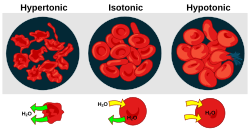Osmotic pressure
This article's lead section contains information that is not included elsewhere in the article. (December 2022) |
This article needs additional citations for verification. (December 2022) |

Osmotic pressure is the minimum pressure which needs to be applied to a solution to prevent the inward flow of its pure solvent across a semipermeable membrane.[1] It is also defined as the measure of the tendency of a solution to take in its pure solvent by osmosis. Potential osmotic pressure is the maximum osmotic pressure that could develop in a solution if it were separated from its pure solvent by a semipermeable membrane
Osmosis occurs when two solutions containing different concentrations of solute are separated by a selectively permeable membrane. Solvent molecules pass preferentially through the membrane from the low-concentration solution to the solution with higher solute concentration. The transfer of solvent molecules will continue until equilibrium is attained.[1][2]
Theory and measurement
Jacobus van 't Hoff found a quantitative relationship between osmotic pressure and solute concentration, expressed in the following equation:
where is osmotic pressure, i is the dimensionless
For more concentrated solutions the van 't Hoff equation can be extended as a power series in solute concentration, c. To a first approximation,
where is the ideal pressure and A is an empirical parameter. The value of the parameter A (and of parameters from higher-order approximations) can be used to calculate
The Pfeffer cell was developed for the measurement of osmotic pressure.
Applications

Osmotic pressure measurement may be used for the determination of
Osmotic pressure is an important factor affecting biological cells.[4] Osmoregulation is the homeostasis mechanism of an organism to reach balance in osmotic pressure.
- Hypertonicity is the presence of a solution that causes cells to shrink.
- Hypotonicity is the presence of a solution that causes cells to swell.
- Isotonicity is the presence of a solution that produces no change in cell volume.
When a
Osmotic pressure is the basis of filtering ("
Derivation of the van 't Hoff formula
Consider the system at the point when it has reached equilibrium. The condition for this is that the chemical potential of the solvent (since only it is free to flow toward equilibrium) on both sides of the membrane is equal. The compartment containing the pure solvent has a chemical potential of , where is the pressure. On the other side, in the compartment containing the solute, the chemical potential of the solvent depends on the mole fraction of the solvent, . Besides, this compartment can assume a different pressure, . We can therefore write the chemical potential of the solvent as . If we write , the balance of the chemical potential is therefore:
Here, the difference in pressure of the two compartments is defined as the osmotic pressure exerted by the solutes. Holding the pressure, the addition of solute decreases the chemical potential (an entropic effect). Thus, the pressure of the solution has to be increased in an effort to compensate the loss of the chemical potential.
In order to find , the osmotic pressure, we consider equilibrium between a solution containing solute and pure water.
We can write the left hand side as:
- ,
where is the activity coefficient of the solvent. The product is also known as the activity of the solvent, which for water is the water activity . The addition to the pressure is expressed through the expression for the energy of expansion:
where is the molar volume (m³/mol). Inserting the expression presented above into the chemical potential equation for the entire system and rearranging will arrive at:
If the liquid is incompressible the molar volume is constant, , and the integral becomes . Thus, we get
The activity coefficient is a function of concentration and temperature, but in the case of dilute mixtures, it is often very close to 1.0, so
The mole fraction of solute, , is , so can be replaced with , which, when is small, can be approximated by .
The mole fraction is . When is small, it may be approximated by . Also, the molar volume may be written as volume per mole, . Combining these gives the following.
For aqueous solutions of salts, ionisation must be taken into account. For example, 1 mole of NaCl ionises to 2 moles of ions.
See also
References
- ^ ISBN 978-0-471-41759-0.
- ISBN 978-0-19-954337-3.
- from the original on 2022-06-18. Retrieved 2019-07-04.
- PMID 34927026.



































